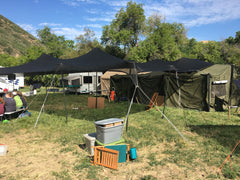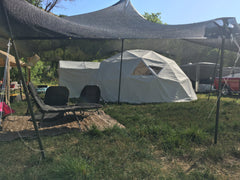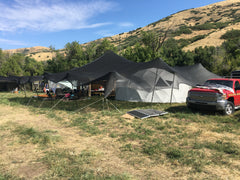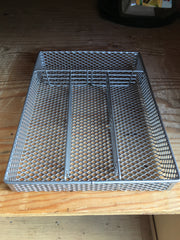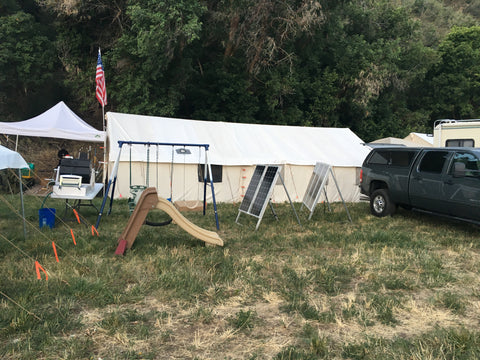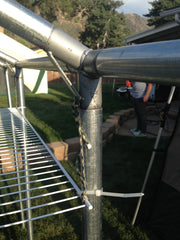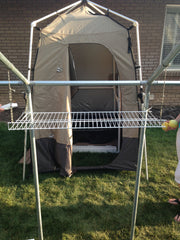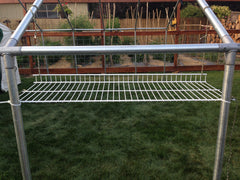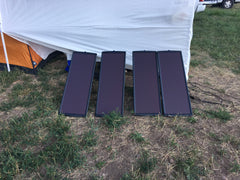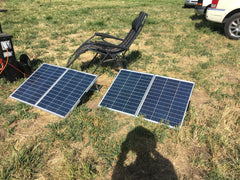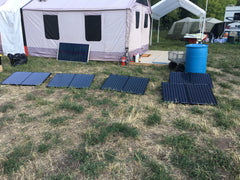We have returned from camp again and have once again learned a lot, just like we did last year -
Day One at the Tifie Prepper Campout, and Tips on How to Set Up a Wall Tent
Keeping Cool, Water, Parade of Tents and a Mouse Trap
My wife and I enjoyed camping with 450 other campers. It was a great camp with classes during the day, parade of tents, pot luck dinner in the evenings and a fantastic speaker every night. The camp was organized in groups of 50. I was a captain who, along with an helpful co-captain, assisted those in our group set up their tents and did our best to help things run smoothly. It was gratifying to see so many of my sinks, showers and rocket stovens being used in camp. I had several ladies tell me how much they appreciated their sink and shower and how they could not imagine camping without them.
Here is our tent and us with our good friends and co-captains, Ron & Sherri Clark.
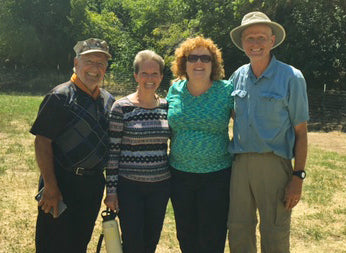
One of the benefits of this annual camp is to setup my gear, use it, and learn what works and what needs improving. Here is my list of things that I learned this year.
Foam Pads
Leveling Wood
Shade Cloth / Insulation
Water Usage
Potty Tips
Ceiling Fan
Electrical System
DC vs AC Fridge
Silverware Tray
1/8" Cord
Water Pump Hose
Swing Set
Wire Shelves
Mice
Battery Placement / Container
Solar Panel Placement
Foam Pads
I developed a sleep system for sleeping on a cot that works well for my wife and me. It is fully described in a free eBook, “12 Tips for Great Sleep While Camping”. One of the main components of the sleep system is a 72” x 30” x 3” foam pad. We purchased our pads 6 years ago. They are available from Home Depot or Smiths Marketplace in Utah for about $20.
My wife noticed this year that her pad seemed softer and didn’t provide as much support. Apparently, over time, this open cell foam pad breaks down slightly. When we got home from camp I saw that I had one that had been stored stored in a plastic garbage sack. It was cleaner and seemed a bit firmer, plus it hadn’t been used. There isn’t a lot of natural light in the garage so sunlight has not been the culprit. I think that with use and storage, over time, that there is some degradation. I will probably get some replacement pads and store them in garbage bags. Getting a good night’s sleep is one of the most important things we can do when camping. Having a sleep system that enables that good sleep is critical.
Leveling Wood
Trying to get every thing level that needs to be level takes time. Our tent spot this year had its ups and downs. There were a lot of things in camp that needed to be level: stoves, cots, cooking table, sink, tables, etc. I had several pieces of thin wood that that I cut up in small pieces to set under legs to help level the camp items. What I soon learned was that the pieces weren’t large enough surface wise or h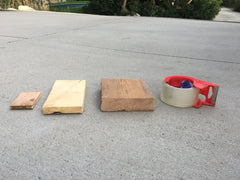
Shade Cloth / Insulation
This was the year of shade cloth at the camp. Last year the daytime temps were in the high 90s. This year it was milder in the 80s. Because of the heat that people experienced last year, especially in their tents, several campers added shade cloth over their tents, which helped keep their tents livable. I was in a spot that was shaded from the afternoon sun, but we did install insulation in the ceiling of our tent on the east side to fight the heat from the morning sun. It did help.
I am going to write a more extensive article on this issue of shade cloth and insulation as it a broad topic by itself. I will include comments from 4-5 campers who used shade cloth this year for the first time. I will include tips and buying suggestions.
Water Usage
You will be amazed how much water you use on a hot day. In our homes we take water for granted. When camping, we have to get water to our tent, make sure it is potable, and get rid of the dirty water.
One of the big water users is washing dishes. One of the issues I had to deal with was the large amount of water that had to be disposed of from washing dishes. If one uses less water to begin with, then less water will have to be disposed of. Here are a couple of articles that talk about how to conserve water when washing dishes by hand:
How To Hand Wash Dishes Using Minimal Water
A few tips from one of the articles:
- Scrape plates with a spatula before food has a chance to dry
- Pre-rinse dishes in a couple of inches of water
- Pre-soak cookware for stubborn stains
- Don’t fill the sink to wash the dishes
- Rinse with hot water into the same sink
- Drip dry
In a previous blog, Clean, Running Water in Your Tent, I shared the water system that I developed to avoid lifting heavy water jugs. One of the features is a water alarm system that warns you when the drainage buckets are full and need to be emptied. The warning system worked. I was outside the tent visiting with someone and my wife was inside the tent doing dishes. All of a sudden I heard a piercing alarm. I didn’t recognize the sound, but knew it was coming from inside the tent. So I went inside and my wife asked me what that horrible sound was. She didn't know either. I quickly determined it was coming from underneath the sink, and one of the buckets was full. I am glad the alarm worked, because last year we didn’t have them. The drain bucket overflowed and we had a mess in our tent kitchen.
Potty Tips
There were porta potties located throughout the camp. The nearest one was about 80 yards from our tent. Instead of traipsing to the porta potties every time, we set up a commode in the shower area of our tent. This was separated by a hanging wall divider for privacy. We then emptied the commode bucket in the porta potties as needed. Here is a link for a folding commode. It is sturdy and folds up for easy storage and transport. This is such a superior solution than a bucket with a lid.
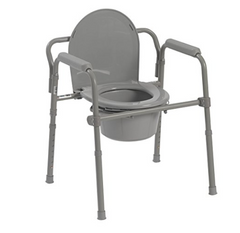
Ceiling Fans
Last year we added a couple of DC fans to our tent and they were a big hit. It was nice on those hot days to move some air in the tent, especially if someone wanted to take a midday nap. We saw that some friends last year put up ceiling fans, so this year I hung our two fans from the ceiling, one in the bedroom and one in the kitchen above the picnic table. It felt great to have air moving and not have the clutter of a fan on a table or on the floor.
I used this gear tie to attach the fan to the frame of my tent. It worked great.-

Electrical System
Last year I learned about my water system. This year I fine tuned my electrical system. In our current homes we flip a switch and lights go on. We don’t think about how the electricity got from the power company, to our home, to the switch, and to the lights. But in a tent, we have to consider where the power is coming from, how much we use, where we want it to go, and how we are going to get it there. Here is a great article on solar power for your long term camp. Solar Power for Your Long Term Camp.
But once you have a power generator in your tent, you need to get the electricity to the appliances you have. These are the things that I power in my tent: lights, fridge, ice maker, and pump for my water system. So I have to have cables to those appliances. For DC, direct current, appliances, such as my lights, fridge and pump, I use a cable with cigarette lighter ends. This is the cable that I use and like. Here is the link to purchase it - DC extension cord.

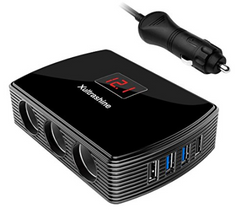
I also use a splitter so that I can run several cables from one location. Here is a nice one: DC Splitter. I was taking all of my DC power from one port on my electrical system and noticed that the connector was hot, so I now have two connectors that I will use to eliminate any overheating of system components.
For AC appliances you can use a regular extension cord that can plug into your inverter.
DC vs AC FridgeI have this Coleman DC fridge.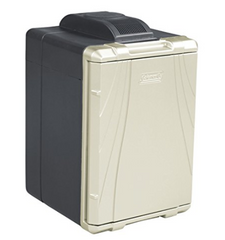 It is a thermoelectric cooler and cools 40 degrees below ambient temperature. I like it because it is DC and I don’t have a 15% loss going through an AC inverter. But it seems like the motor is always running. It was drawing about 4.25 amps. And I can’t keep things below 40 to avoid spoilage and there is no freezer compartment. My friend has a small AC fridge with a freezer compartment. With his fridge, when he makes ice, he can store it in the freezer compartment. I just did some shopping on homedepot.com and found a 4.3 cubic feet mini fridge that uses only 1.5 amps and costs $249. It has a freezer compartment. I now have this new AC fridge in my supply trailer.
It is a thermoelectric cooler and cools 40 degrees below ambient temperature. I like it because it is DC and I don’t have a 15% loss going through an AC inverter. But it seems like the motor is always running. It was drawing about 4.25 amps. And I can’t keep things below 40 to avoid spoilage and there is no freezer compartment. My friend has a small AC fridge with a freezer compartment. With his fridge, when he makes ice, he can store it in the freezer compartment. I just did some shopping on homedepot.com and found a 4.3 cubic feet mini fridge that uses only 1.5 amps and costs $249. It has a freezer compartment. I now have this new AC fridge in my supply trailer.
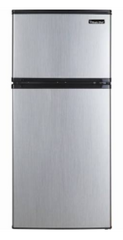
Silverware Tray
We have a deluxe Cabelas camp kitchen and appreciate the countertops, hooks and storage. We bought some containers that fit in the cupboard area. We kept our eating utensils in one of the containers but it was a hassle to open every time we wanted a spoon, fork or knife. I had a silverware tray that I left home thinking we wouldn’t use it. I wish I would have taken it. It would have been much more convenient to have on a counter top or shelf for easy access.
1/8" Cord
A good friend of mine told me about 1/8" cord that was fairly inexpensive. He has a 5,000' spool. I asked why he has so much. His reply was that this cord for him is like duct tape. He uses it on everything from camp gadgets, to bow drill, shade tarp tie down, boot lace, cloths line, tent reinforcement, etc. I purchased several 1,000' rolls and found, like him, that it is very helpful. I used it on the wire shelves. It is a bit less expensive than paracord. I have both. This is where I bought it - 1/8" nylon cord.
Water Pump Hose
I learned about an issue with my tent water system that I need to fix. The system is designed to pump water from portable jugs into a 55 gallon barrel. When I put the hose into the water jugs, the hose curls and has a hard time getting to the water at the bottom of the jugs. I am going to attach a piece of PVC to the hose so I can place the hose/pipe into the jug and will be able to pump out all of the water without having to adjust the hose.
Swing Set
I know, some of you are thinking, “Why is he talking about a swing set while camping? He teaches to prioritize, with “A” Survival, “B” Comfort and “C” Luxury, see The Four Lists of Preparation. Where does a swing set fit in and how does one store and transport such a thing?” I have had grand children with me the past several camps.
The past several years I took some swing seats and rope to camp so the kids would have a place to play. The kids loved this play area. I plan on having young grandchildren camp with me and find something like this for them to play on a close A/B ranking.
This year, our camp area was fenced off and there were no trees to tie a swing to. So I found a free used swing which I refurbished. I set it up at camp, installing some leg anchors, and the kids had a great time swinging. I also brought a foldable slide. It was used not only by my two grand daughters, but other kids from the camp. The swing set is again disassembled and stored away until we have another long-term camp.
Wire Shelves
I had previously designed some wooden shelves that attached to my tent frame. I found that system awkward and unwieldy. I had some wire shelves from another project in my supplies and I found that if I use a zip tie at the back of the shelf tying it to a vertical pole and a piece of cord at the front of the shelf attaching it to a rafter that I had usable shelving that was inexpensive, compact and functional. This year I put up some in the kitchen and one section in the shower area to hold toiletries. I forgot to take pictures of how I installed them at camp, but I am including some pictures of when I tested the concept. I did a couple of things differently at camp. I put the lip on the shelf facing down at the back. This added stability. I used cord only on the front and not the back. A zip tie attaching the shelf to the frame in back was sufficient to hold the shelf securely. I used the tautline hitch when tying the front of the shelf to the frame. This adjustable knot allowed me to adjust the height of the shelf.
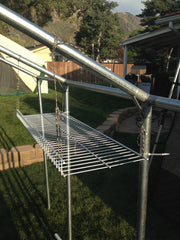
Mice
There were mice in our tent. I placed a trap out but didn't catch any. Here are two things that we should have done better in order to catch the mice and not have them wandering all over our kitchen. First, we weren't diligent in keeping food droppings off the floor. We had two grand daughters with us, 5 and 3. Spilt food was a common occurrence and we weren't diligent in cleaning it up. Second, we should have stored our food in plastic bins during the night so the critters couldn't get to it. We forgot to bring some bins, so there was food left out at night. I think that if we had done a better job of not providing ready food for them then they would have been attracted to the trap and we could have caught and relocated them.
By the way, here is the mouse trap I recommend. It can hold multiple mice.
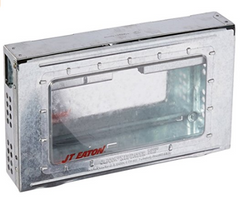
Battery Placement / Container
I have batteries with my home solar system. When I go camping, I take one along and use it with my solar power system. I was told by a friend who has done extensive research on batteries that I should have the battery outside the tent. Even though it is a non-venting battery, he said that it still gives off some fumes. The fumes are not healthy and are detrimental to the cotton in my wall tent. He suggested that I store them at least two feet outside the tent in an insulated box that is vented. I figured the best way to do that is to find a cooler that is the right size, drill a few holes for the required cables, and store it outside the tent. The batteries are 29”x11”x11” and weigh almost 100 pounds. I’ll need to find a sturdy cooler. That is one of my next projects. This is probably the cooler I will end up with. It has the size needed to hold my batteries. I will also need to get longer cables to connect the batteries to each other and my power panel.

Solar Panel Placement
I noticed that there are more and more campers using solar power. I love having electricity in my tent. As I walked around camp I saw that there are some real issues on how people place/position their panels. This works for a short term camp. But it is evident that there needs to be some work to properly protect them and accommodate for bad weather (snow, wind) and from people stepping on them.
Here is a picture of my panels that can be adjusted for the sun angle, can be secured for wind, allows snow to sluff off, and fold up flat for easy storage and transport.
I provide a complete description of these panels in the blog post: Solar Power for your Long-Term Camp. I do make these custom frames. If you are interested, email me at michael@deluxecamping.com.
I hope that my experiences help you make your camping experience more clean and comfortable.
Look for the next blog post soon on how to make your tent more comfortable using shade cloth and/or insulation.
 USD
USD EUR
EUR



